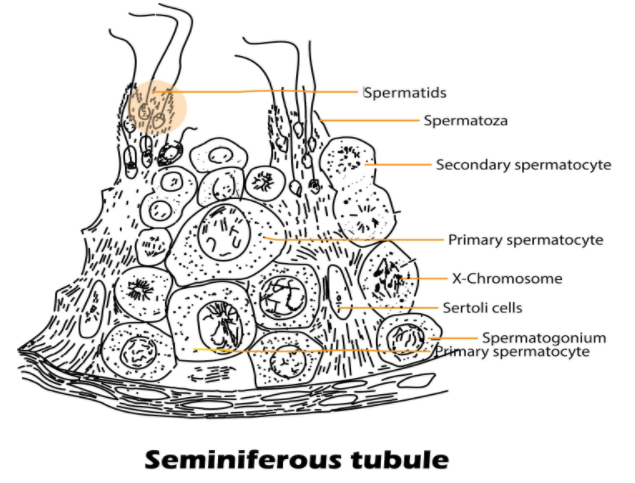Answer
411.6k+ views
Hint: In humans, the seminiferous tubules are located within the male testes. These cells are present within testes and it is the location where meiosis and spermatogenesis (the process of producing spermatozoa) occurs.
Complete answer:

The Sertoli cells are surrounded by spermatogenic cells on the epithelial interior, these cells and stem cells exteriorly make up the seminiferous tubules.
Sertoli cells- is a nurse cell which creates a hemato-testicular barrier and gives nourishment to the spermatozoa. The sperm heads become embedded in these cells after the process of spermiogenesis. They are finally released from the seminiferous tubules by a process called spermiation.
Primary spermatocyte- they are are diploid (2N) cells and after completing the first meiotic divisions leads to the formation of two equal, haploid cells called secondary spermatocytes. These contain half the number of chromosomes and thereby give rise to male gamete-sperm.
Spermatogonia- the spermatogonia (plural Spermatogonium) is an undifferentiated male germ cell and is present on the inside wall of seminiferous tubules. It multiplies by mitotic division and increases in numbers and is diploid and contains 46 chromosomes. There are three types of spermatogonia:
Type A (dark)- they are cells with dark nuclei and are reserve spermatogonial stem cells. They don’t usually go through mitosis.
Type A (pale)- they are cells with pale nuclei and are the spermatogonial stem cells. They undergo active mitosis to produce Type B cells.
Type B cells- they grow to become primary spermatocytes.
Spermatozoa- These are the male sex cells or sperms and are added to the semen before coming out of the body. A spermatogonium undergoes spermatogenesis to form mature spermatozoa.
Note: Sertoli cells of the testicles are activated by follicle-stimulating hormone (FSH) secreted by the adenohypophysis. It has an FSH receptor on its membranes. These cells can only proliferate or divide rapidly in the first year of life.
Complete answer:

The Sertoli cells are surrounded by spermatogenic cells on the epithelial interior, these cells and stem cells exteriorly make up the seminiferous tubules.
Sertoli cells- is a nurse cell which creates a hemato-testicular barrier and gives nourishment to the spermatozoa. The sperm heads become embedded in these cells after the process of spermiogenesis. They are finally released from the seminiferous tubules by a process called spermiation.
Primary spermatocyte- they are are diploid (2N) cells and after completing the first meiotic divisions leads to the formation of two equal, haploid cells called secondary spermatocytes. These contain half the number of chromosomes and thereby give rise to male gamete-sperm.
Spermatogonia- the spermatogonia (plural Spermatogonium) is an undifferentiated male germ cell and is present on the inside wall of seminiferous tubules. It multiplies by mitotic division and increases in numbers and is diploid and contains 46 chromosomes. There are three types of spermatogonia:
Type A (dark)- they are cells with dark nuclei and are reserve spermatogonial stem cells. They don’t usually go through mitosis.
Type A (pale)- they are cells with pale nuclei and are the spermatogonial stem cells. They undergo active mitosis to produce Type B cells.
Type B cells- they grow to become primary spermatocytes.
Spermatozoa- These are the male sex cells or sperms and are added to the semen before coming out of the body. A spermatogonium undergoes spermatogenesis to form mature spermatozoa.
Note: Sertoli cells of the testicles are activated by follicle-stimulating hormone (FSH) secreted by the adenohypophysis. It has an FSH receptor on its membranes. These cells can only proliferate or divide rapidly in the first year of life.
Recently Updated Pages
In a flask the weight ratio of CH4g and SO2g at 298 class 11 chemistry CBSE

In a flask colourless N2O4 is in equilibrium with brown class 11 chemistry CBSE

In a first order reaction the concentration of the class 11 chemistry CBSE

In a first order reaction the concentration of the class 11 chemistry CBSE

In a fermentation tank molasses solution is mixed with class 11 chemistry CBSE

In a face centred cubic unit cell what is the volume class 11 chemistry CBSE

Trending doubts
Which are the Top 10 Largest Countries of the World?

Difference Between Plant Cell and Animal Cell

Give 10 examples for herbs , shrubs , climbers , creepers

Fill the blanks with the suitable prepositions 1 The class 9 english CBSE

Difference between Prokaryotic cell and Eukaryotic class 11 biology CBSE

Write a letter to the principal requesting him to grant class 10 english CBSE

Change the following sentences into negative and interrogative class 10 english CBSE

Name 10 Living and Non living things class 9 biology CBSE

List some examples of Rabi and Kharif crops class 8 biology CBSE



